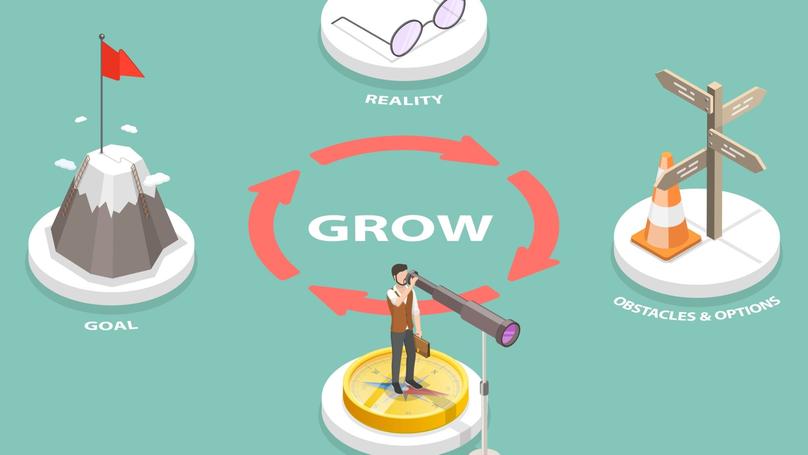GROW Model

What is the GROW model in coaching?
The GROW model is a structured approach to problem solving, goal setting, teaching, and self-development. Traditionally, it is defined as a comprehensive process comprising four stages, enabling individuals to make informed decisions, address particular situations, and rapidly acquire new knowledge. The GROW model is most often used in mentoring, business training, and life coaching.
GROW is an acronym representing the four stages: Goal, Reality, Options, and Way Forward (or Will). Initially, it's crucial to identify your desired results and the goal you aim to achieve. Following this, you need to assess the current situation, recognising what resources you have and what you need to reach your goal. The next step involves brainstorming for potential solutions or opportunities to implement your initial ideas. Finally, you develop a detailed plan or specific actions that will guide you towards your goal. To maximise the effectiveness of each stage, the GROW model incorporates questioning techniques, which will be discussed later.
While the GROW method might appear straightforward, it provides comprehensive and precise goal setting and the development of effective strategies to achieve those goals. This versatile tool is valuable for addressing work-related challenges and fostering self-development. Consequently, GROW is widely used for personal goals and team coaching.
Who developed the GROW model?
The GROW model has gained significant traction in the business world over the past decade. However, it was developed in the 1980s by Sir John Whitmore, a prominent business coach in the UK. Whitmore introduced the term GROW and detailed the method in his 1992 book, "Coaching for Performance." This bestseller sold over 500,000 copies globally and was translated into 17 languages. The GROW model was later refined by business coaches and mentors Alan Fine and Graham Alexander and McKinsey senior consultant Max Landsberg, who discussed it in the 1996 book, "The Tao of Coaching."
The GROW model template

There isn't a one-size-fits-all template for applying the GROW technique; you can adapt it to a format that suits you best. Visualising the data using a table is often the most effective way to present the information clearly.
Remember, the GROW model comprises four key factors:
-
G - Goal or aim.
-
R - Reality or actuality.
-
O - Options or circumstances (or decisions).
-
W - Will or intentions.
Following each factor, the GROW table should have four columns. In action, the model looks like this:
|
Goal |
Reality |
Options |
Will |
|
Increase the department's KPI within three months |
The team does not show initiative, often misses deadlines, and employees are not motivated enough |
Enhancing employees' professional skills and motivating the team is essential |
Enrol in a corporate advanced training course, organise seminars and workshops led by industry experts, conduct a series of motivational activities, and implement new standards for the quality and quantity of KPIs |
|
Goal |
Reality |
Options |
Will |
|
Achieve a promotion within the next year |
Lacking leadership skills, hesitant to take responsibility, and limited experience in managing people |
Enrol in a leadership thinking course, conquer the fear of responsibility, and build confidence in decision-making |
Talk to management about career prospects and professional growth opportunities, enhance your skills, and begin leading small project teams |
Let's delve into how to complete each column correctly.
The first stage is goal setting, which clearly defines what you aim to achieve with this model. Whether you're using GROW for personal use or team purposes, it's beneficial to answer the following questions at this stage:
-
What do I/we want to achieve?
-
Does this goal align with the company's overall development strategy or my personal plans? Will it help achieve new milestones?
-
What would be the ideal outcome?
-
What would be the reason for this?
-
How will I determine that the goal has been achieved?
-
What benefits will I gain by achieving this goal?
You should proceed to the second stage only after answering these questions.
The next step is to evaluate the current situation. At this stage, it's crucial to identify any problems, obstacles, or contentious issues that might hinder achieving your goal. This is particularly important because even experienced professionals can struggle to resolve difficulties if they don't thoroughly assess the situation and may overlook valuable information. Solutions emerge naturally once you or your team examine the problem and address every detail. To do this, consider answering the following questions:
-
What is the current situation? What are the areas of dissatisfaction?
-
How does the current situation impact my life, career, or team performance? What are the outcomes or effects of the current situation?
-
Who is involved in this?
-
What resources do I/we have right now?
-
Have any steps been taken to address the situation? What were the outcomes?
-
Has a similar situation occurred before?
-
What is hindering the resolution of the current situation?
-
What is missing to resolve the situation?
Examining the current situation and maintaining an objective view of reality helps you stay connected with the external environment, consciously understand what is happening, and find the most suitable solutions. This leads to the next stage: exploring new opportunities to resolve challenging situations.
At the third stage, conducting a thorough brainstorming session is crucial to explore potential future scenarios to develop the situation. Generate as many possible outcomes for the current situation as possible, considering all possibilities and alternatives. There should be numerous potential developments if the previous stage involves a comprehensive evaluation of the current situation. Use the following questions to guide this process:
-
What are my/our capabilities right now?
-
What else can I/we do?
-
What are the pros and cons of each option?
-
What challenges might arise with each option?
-
What steps should be taken initially?
-
What actions are necessary to achieve the best result? Additionally, what else should be considered?
-
What will happen if...?
-
What are the primary obstacles to achieving the goal?
-
How can they be overcome?
Examine the situation from every possible angle, including seemingly impossible options. You might discover a way to make them work.
The final stage involves setting your intentions. By now, you or your team should clearly understand your current situation, your goals, the potential ways to achieve them, and the obstacles in your path. The next step is to create a plan-an identifiable sequence of actions to employ your ideas and complete the GROW cycle. The following questions will help you determine where to begin:
-
What should be prioritised first?
-
What comes next? What sequence of actions is the most effective?
-
What is the timeline for implementing each step?
-
What could get in the way?
-
How can these problems be overcome?
-
How should progress be monitored?
By doing this, you'll develop a clear plan and strategy for achieving your goal. This approach allows you to systematically move from one step to the next, considering potential challenges, evaluating even the smallest details, and tracking your progress throughout the process.
How to use the GROW model most effectively: advice from Lectera experts

We have several recommendations for each stage to ensure the GROW model yields tangible results in the near future.
Tip # 1. Use the SMART technique at the first stage
Before setting a goal, ensure it aligns with the SMART criteria:
-
S - Specific: The goal should be as clear and precise as possible, leaving no room for ambiguity or misinterpretation. It should be devised in a way that requires no further clarification.
-
M - Measurable: Assessing progress towards the goal is essential. Define the target in numerical terms. For example, instead of aiming to increase revenue, specify increasing revenue to $10,000 monthly.
-
A - Attainable: The goal should be realistic and achievable with the resources you have available.
-
R - Relevant: The goal should align with the current situation, support the overarching objective, and not hinder it. For example, instead of simply launching numerous new media advertisements, aim to attract a thousand new users, clients, or buyers through media advertising. This is a realistic and achievable goal.
-
T - Timely: The goal should have a clear deadline tied to an exact timeframe. For example, aim to prepare a quarterly report by the end of the month or improve KPIs within six months.
By applying the SMART criteria within the GROW framework, you'll find it much easier to observe your progress towards your goal and achieve results more quickly.
Tip #2. Use the additional SCORE model at the second stage
While gathering and organising information, identifying cause-and-effect relationships, and examining the current situation, it can be helpful to use the SCORE technique. This acronym stands for:
-
S - Symptom: This refers to the current information and what is happening now, whether in the overall business, a specific department of a large company, personal life, etc.
-
C - Cause, or why this particular situation has arisen. What led to it?
-
O - Outcome. This is the desired result, what needs to be achieved, why and how exactly it could be changed, and in what way?
-
R - Resources, what is required to rectify the situation, and the definite resources needed to accomplish the goal.
-
E - Effect, the anticipated outcomes and benefits of achieving the goal, such as the advantages it will provide for the company's future development.
Typically, this technique is employed for quickly gathering information and concentrating on crucial details. It is a universal method to organise the entire situation, helping you understand how to navigate from the current situation to achieving your desired outcome.
Tip # 3. Use different brainstorming techniques
It would be best to employ various brainstorming techniques to explore as many potential outcomes and alternatives as possible during the third stage. One particularly intriguing method is the "Six Thinking Hats" technique, created by British psychologist Edward de Bono. He likened an individual's perception of reality to wearing a hat. Suppose you continually wear the same hat (i.e., never change your perspective or view a situation, object, or experience with fresh eyes). In that case, your thinking will become stereotyped, leaving no room for creativity and innovation. De Bono's method addresses this issue.
You will need six participants to conduct a brainstorming session using this psychological technique (though fewer may suffice depending on your situation). Each participant will metaphorically wear a different hat. For instance, the white hat focuses on facts, objectivity, and accurate data. The person wearing this hat should strive to be impartial and independent. The red hat represents feelings and emotions. The person wearing this hat evaluates the facts from their perspective, discussing the feelings these facts evoke and how to manage them. The black hat is for the critic, who highlights all the flaws in the proposed ideas. The yellow hat is worn by the team member who seeks out positive aspects and advantages in every situation. It's crucial to highlight the benefits of various options, especially when they are scarce. The green hat represents creativity, with its wearer proposing the most unexpected and sometimes challenging solutions to the current situation. Finally, the blue hat is worn by the participant who joins the brainstorming session at the end to organise ideas and determine the outcome.
This technique can be repeated multiple times, allowing each participant to try different hats. This approach ensures that the brainstorming session yields valuable and diverse information. Additionally, gathering feedback from each participant after every session is essential.
Tip # 4. Learn to ask questions correctly
The key to effectively using the GROW model is asking questions that progressively lead you closer to your desired outcome. Each question should have a specific focus and serve as one of many steps towards achieving what was conceived at the first stage.
Aim to ask open-ended questions that invite detailed responses rather than just "yes" or "no" answers. You can pose similar questions at different stages and vary their wording, but ensure that the answers are as detailed and comprehensive as possible.
If you are a coach using the GROW model with a client, practice active listening. Encourage the client to speak more, reflect on what has been said, and revisit the topic as needed. Fully immerse yourself in the process, approaching both the formulation of questions and answers and the overall psychological climate during work using the GROW technique.
Pros and cons of the GROW model

We've already established that the GROW model is a powerful tool for achieving specific results, effective not only in business and career but also in personal life and relationships with others and yourself. Let's explore the additional advantages of this model in more detail:
-
The GROW model enables you to divide complex tasks into smaller, more manageable, and quickly attainable goals.
-
Using the GROW model provides a clear action plan, enabling you to resolve even the most challenging conflicts and navigate any difficulties.
-
This model aids in identifying actual needs and letting go of unnecessary things.
However, every method has its drawbacks. For instance, the GROW model is often criticised for being too formal and structured. In simple terms, its rigid application rules may overlook alternative scenarios, the human factor, and psychological mechanisms in certain situations.
Conclusion
Considering the advantages and disadvantages of the GROW model, it's essential to recognise that it is just one tool among many. That helps you gather and organise all the necessary information for decision-making. Despite its drawbacks, this methodology is widely used by coaches and managers of large companies to achieve success across various fields. The GROW model can be highly beneficial when combined with other complementary methods. It helps you organise available information, develop a sound strategy, and understand the steps needed to achieve your desired results more quickly.























